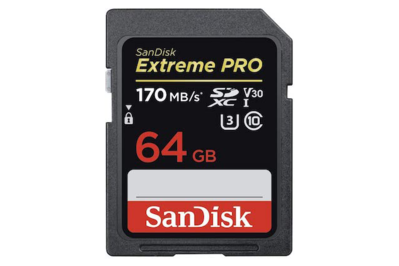
Top pick
The 64 GB SanDisk Extreme Pro proved to be the top SD card in our latest round of testing, with the best ratio of read and write speeds, as well as high-speed real-world performance during burst shooting. It’s an affordable option that outperforms most other UHS-I cards, and it’s covered by SanDisk’s limited lifetime warranty.
The SanDisk Extreme Pro is a Class 10, U3, V30 card, with a quoted read speed of 170 MB/s. That makes it fast enough to record 1080p and 4K video. In our CrystalDiskMark read and write tests, it performed at at little more than 93 MB/s and 84 MB/s, respectively, easily beating out cards from other manufacturers.
| Model | Read MB/s | Write MB/s |
| Lexar Professional 633x | 93.91 | 76.25 |
| SanDisk Extreme Pro | 93.78 | 84.58 |
| SanDisk Extreme | 93.43 | 65.91 |
| SanDisk Ultra | 86.8 | 42.92 |
| Transcend High Speed | 93.02 | 67.13 |
Write speeds are the most important factor for SD cards, and the increased write speed of higher-end cards allows a photographer to shoot in burst mode, raw, and 4K video with fewer delays in processing time. In our testing, we found that the Extreme Pro outperformed comparable cards from Lexar and Transcend, which means a camera would be able to shoot more images in a shorter amount of time with the Extreme Pro than it would with any of the other UHS-I cards we tested. The previous generation of this card—our former pick in this guide—was the fastest card we tested then, too. (You can spot the new Extreme Pro by the quoted 170 MB/s rating on the card’s label. The older version now costs more than the new model and is quoted at only 95 MB/s, so we no longer recommend it.)
In our read tests, the Extreme Pro fell in line with other comparable models, which all produced read speeds within 1 MB/s of one another. A faster read speed means less time spent waiting for your photos and video to transfer from your card onto your computer.
We also tested each card’s real-world burst-shooting speed in a full-frame mirrorless camera, the Sony α7 III. For these tests, we recorded the sound of the shutter closing as we shot a burst of raw images. The resulting waveforms offer a visual representation of each card’s speed. The large group of spikes at the beginning of each waveform represents a burst of shots, which fill the camera’s buffer and must be written to the SD card before you can shoot more photos. Each spike after that represents a single shot, and between those spikes the camera is writing files to the SD card. In short: More, closely clumped spikes means a faster SD card.

In the Sony α7 III, the SanDisk Extreme Pro had practical write speeds that were nearly identical to those of our runner-up, the Sandisk Extreme. SD cards we tested from Lexar and Transcend performed slightly faster during our in-camera tests but didn’t offer significant improvement over the Extreme Pro.
This newest generation of the SanDisk Extreme Pro comes in only the 64 GB size or larger and costs approximately the same price per gigabyte for the 64 GB and 128 GB models.
SD cards are more durable than hard drives because they lack moving parts, and they can survive being bumped around and dropped. Like many SD cards, the SanDisk Extreme Pro is rated to survive up to 72 hours in 1 meter of saltwater or freshwater, can withstand temperatures ranging from –13 °F to 185 °F, and is unaffected by airport X-rays. It’s also backed by a lifetime limited warranty, which covers the SD card as long as it isn’t used improperly.





